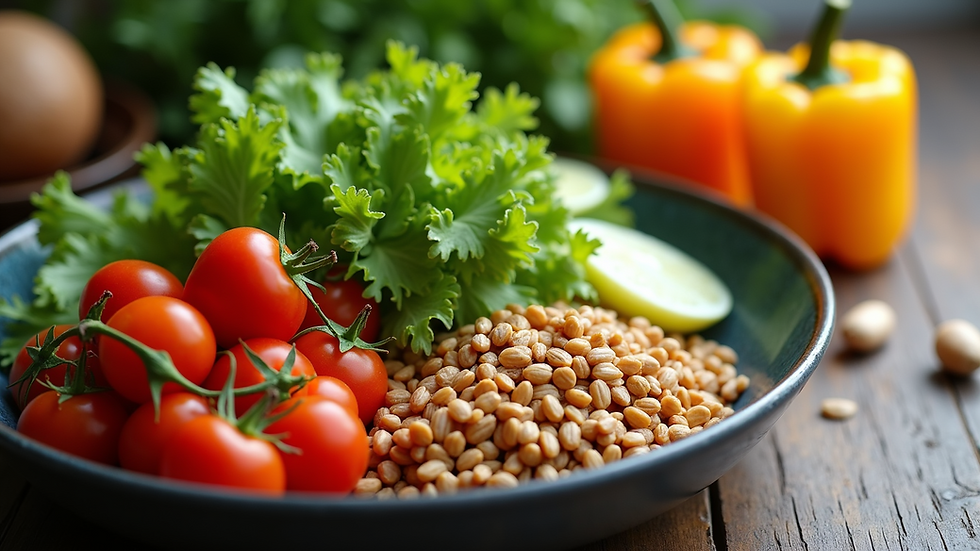Understanding the Low Amylose Diet for Health
- keriannzipperer2
- 1 day ago
- 3 min read
If you’ve been struggling with chronic health issues and feel like traditional approaches haven’t worked, you’re not alone. Sometimes, the key to feeling better lies in the food we eat. Have you ever heard of the low amylose diet? It’s a nutritional approach that might just be the missing piece in your wellness puzzle. Let’s explore what it is, why it matters, and how you can start incorporating it into your life.
What Is a Low Amylose Diet Guide?
Amylose is a type of starch found in many foods, especially in grains and potatoes. It’s a long chain of glucose molecules that digests slowly, but for some people, it can cause digestive discomfort or blood sugar spikes. A low amylose diet focuses on reducing foods high in amylose to support better digestion, blood sugar control, and overall health.
Why does this matter? If you’ve been dealing with unresolved health issues like bloating, fatigue, or blood sugar imbalances, reducing amylose intake might help ease these symptoms. It’s not about cutting out carbs entirely but choosing the right types that work better for your body.
Foods High in Amylose
White and brown rice (especially high-amylose varieties)
Potatoes (especially waxy types)
Corn
Wheat and barley
Legumes like lentils and chickpeas
Foods Lower in Amylose
Certain types of rice like jasmine or basmati (lower amylose content)
Sweet potatoes
Quinoa
Non-starchy vegetables like leafy greens, zucchini, and broccoli
By focusing on these lower amylose options, you can still enjoy a balanced diet without the discomfort or blood sugar swings.

Why Choose a Low Amylose Diet Guide?
You might be wondering, “Is this diet really for me?” If you’ve tried various diets without success, a low amylose diet could offer a fresh perspective. Here’s why:
Improved digestion: Some people find that high amylose starches ferment in the gut, causing gas and bloating. Lowering amylose can ease these symptoms.
Better blood sugar control: Amylose digests slowly but can still cause blood sugar spikes in sensitive individuals. Reducing it helps maintain steady energy.
Supports gut health: A balanced diet with the right starches encourages a healthy microbiome, which is crucial for overall wellness.
Personalised nutrition: This diet encourages listening to your body and adjusting foods based on how you feel.
If you’re ready to take control of your health, this approach offers a gentle, supportive way to start.
How to Start a Low Amylose Diet Guide
Starting a new diet can feel overwhelming, but it doesn’t have to be. Here’s a simple plan to help you ease into a low amylose lifestyle:
Identify high amylose foods in your current diet. Keep a food diary for a few days and note any symptoms after eating.
Swap high amylose foods for lower amylose alternatives. For example, replace regular potatoes with sweet potatoes or white rice with basmati rice.
Focus on whole, unprocessed foods. Fresh vegetables, lean proteins, and healthy fats support your body’s healing.
Cook foods in ways that reduce amylose impact. Soaking and cooking rice thoroughly can lower resistant starch content.
Listen to your body. Notice how you feel after meals and adjust accordingly.
Remember, this is a journey. Small changes add up to big improvements over time.

Practical Tips and Meal Ideas
To make this diet work for you, here are some practical tips and meal ideas:
Breakfast: Try a quinoa porridge with cinnamon and berries instead of traditional oats.
Lunch: A salad with grilled chicken, avocado, and a side of roasted sweet potatoes.
Dinner: Stir-fried vegetables with basmati rice and a lean protein like fish or tofu.
Snacks: Fresh fruit, nuts, or vegetable sticks with hummus.
Also, consider batch cooking meals to save time and reduce stress during busy days. Planning ahead helps you stick to your goals without feeling deprived.
Where to Find More Resources
If you want to dive deeper, there are excellent resources available. For example, you can download a comprehensive low amylose diet pdf that offers detailed guidance, recipes, and tips to support your journey.
Taking this step shows you’re committed to finding lasting solutions. Remember, healing is personal, and having the right tools makes all the difference.
Embracing a Healthier You
Changing your diet is more than just food choices - it’s about reclaiming your health and vitality. The low amylose diet guide offers a compassionate, practical way to support your body’s needs. You don’t have to do it alone. With patience and persistence, you can find relief and renewed energy.
Are you ready to explore this path? Start small, stay curious, and celebrate every positive change. Your body will thank you.
If you want to learn more about holistic approaches and personalized nutrition, keep exploring and stay connected. Your health journey is unique, and every step forward is a victory.



Comments